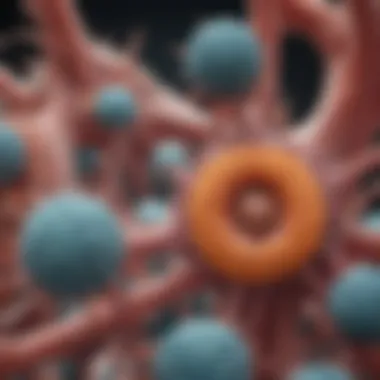Systemic Atrophy: Mechanisms and Health Implications


Intro
Systemic atrophy is a complex phenomenon characterized by the progressive degeneration of various tissues and organs in the body. This multifaceted process can lead to significant health challenges that require comprehensive understanding and management. The aim of this article is to provide an in-depth examination of the mechanisms underlying systemic atrophy, its potential causes, and the implications for health and disease.
Understanding systemic atrophy involves looking at not only the biological processes but also how these changes manifest in clinical settings. Awareness of this condition is essential for both researchers and healthcare professionals as it affects the diagnosis and treatment protocols for various diseases.
Through this exploration, we will highlight the intricate relationships between systemic atrophy, health, and overall well-being, while drawing attention to the potential for better diagnostic methods and therapeutic interventions.
Definition of Systemic Atrophy
Systemic atrophy describes a broad spectrum of degenerative changes affecting multiple tissues or organ systems in the body. Understanding this concept is fundamental, as it lays the groundwork for appreciating the interconnections among various pathologies. Moreover, knowing the definition is crucial for recognizing signs and symptoms, facilitating timely interventions and preventing further complications. Systemic atrophy is not merely an isolated issue; rather, it reflects underlying dysfunctions or deficiencies affecting overall health.
General Overview
Systemic atrophy involves a reduction in the size and function of tissues or organs. This phenomenon may result from a variety of factors, including aging, hormonal imbalances, or nutritional deficiencies. It is not limited to one organ system; rather, it can manifest across different regions of the body, including muscles, nerves, and internal organs. One of the key aspects of systemic atrophy is that it suggests a failure of homeostasis and can have cascading effects on overall health.
The implications of systemic atrophy are significant. For instance, muscle atrophy can lead to decreased mobility and increased fall risk, particularly in older adults. On the other hand, atrophy in organs such as the liver or kidneys can compromise essential bodily functions, potentially leading to serious health concerns. As such, understanding systemic atrophy is essential for recognizing its impacts across various domains of health.
Types of Systemic Atrophy
There are several identified types of systemic atrophy, each characterized by specific features and affected areas of the body. Some common types include:
- Muscle atrophy: Refers to the wasting away of muscle tissue, often due to disuse, malnutrition, or specific diseases.
- Cerebral atrophy: Involves the loss of neurons and the connections between them, typically associated with neurodegenerative diseases like Alzheimer’s.
- Fatty atrophy: This type of atrophy leads to the replacement of normal tissues by fat, which can occur in certain chronic diseases or due to hormonal changes.
Overall, recognizing the types of systemic atrophy can assist health professionals in diagnosing underlying conditions and determining the most effective course of treatment.
Mechanisms of Atrophy
Understanding the mechanisms of atrophy is crucial for grasping how systemic atrophy impacts health. Various biological processes contribute to atrophy, and these processes underscore the complex nature of tissue degeneration. By delving into these mechanisms, we can better analyze how atrophy affects different systems in the body and identify potential areas for intervention.
Cellular Pathways
Cellular pathways are essential for maintaining tissue homeostasis. During atrophy, these pathways undergo significant alterations. One primary pathway is the ubiquitin-proteasome system. This system is responsible for degrading misfolded or damaged proteins. In cases of atrophy, an increase in protein degradation leads to a loss of muscle mass and, ultimately, organ dysfunction.
Another critical pathway involves autophagy. This process helps to remove dysfunctional cell components. During systemic atrophy, impaired autophagy can exacerbate cellular stress and contribute to further degeneration. Studies indicate that enhancing autophagy might help mitigate some effects of atrophy, but further research is necessary to confirm this.
Key cellular pathways to consider include:
- Ubiquitin-proteasome system
- Autophagy
- Insulin signaling pathway
These pathways activate or inhibit various genes that play roles in cellular growth and survival. Understanding these pathways is not only important for comprehending atrophy but also for illuminating potential therapeutic targets.
Hormonal Influences
Hormones play a significant role in regulating metabolism and tissue integrity. In the context of systemic atrophy, hormonal changes can substantially influence the rate of degeneration. Cortisol, a stress hormone, is known to promote protein catabolism, thus contributing to muscle wasting. If cortisol levels remain elevated over prolonged periods, it can result in systemic atrophy.
Similarly, the role of insulin should not be overlooked. Insulin not only regulates glucose but also promotes muscle growth. When insulin sensitivity decreases, as seen in conditions like diabetes, it may precipitate atrophy as muscle maintenance becomes compromised.
Some hormonal influences to take into account are:
- Cortisol: Increases degradation of proteins
- Insulin: Promotes muscle growth
- Thyroid hormones: Regulate metabolism and energy expenditure
Considering the hormonal environment can shed light on how systemic atrophy develops and progresses. Intervening at the hormonal level may lead to better management strategies for atrophy-related conditions.


Understanding the interplay between cellular pathways and hormonal influences is vital in addressing systemic atrophy's implications for health.
By deepening knowledge in these areas, researchers and healthcare professionals can work toward developing more effective treatment and prevention strategies.
Causes of Systemic Atrophy
The causes of systemic atrophy are numerous and multifaceted. They play a crucial role in understanding how this condition manifests and progresses. Recognizing the underlying factors can help in developing targeted therapeutic strategies and preventative measures. Analyzing these causes is essential for anyone studying systemic atrophy in the context of health and disease.
Genetic Factors
Genetic predisposition is one of the primary contributors to systemic atrophy. Certain genetic mutations may lead to dysfunction in cellular processes. For example, inherited conditions, like muscular dystrophies and neurodegenerative diseases, showcase how genetic factors can affect tissue health. Research has identified various gene mutations responsible for these conditions, often linked to protein synthesis and cellular maintenance processes. This understanding highlights the significance of genetic testing and counseling in affected families. The interplay between genes and the environment can further complicate this relationship.
Environmental Influences
Environmental influences also have a broad impact on systemic atrophy. Factors such as pollution, exposure to toxins, and lifestyle choices can contribute to tissue degeneration. Chronic exposure to harmful substances may lead to cellular stress, resulting in atrophy over time. Furthermore, sedentary behavior is linked with muscle wasting. Public health initiatives aimed at reducing exposure to environmental toxins and promoting physical activity can help mitigate these effects and support overall well-being.
Nutritional Deficiencies
Nutritional deficiencies represent another significant cause of systemic atrophy. A lack of essential nutrients, such as proteins, vitamins, and minerals, can disrupt cellular function. For instance, inadequate intake of vitamin D can lead to reduced bone health due to atrophy of bone tissue. Protein deficiency may contribute to muscle wasting, known as cachexia, seen in various chronic diseases. Addressing nutritional needs through a well-balanced diet is vital for prevention and management. Nutritional assessments and interventions should be part of the care plans for individuals at risk of systemic atrophy.
Impact of Systemic Atrophy on Health
Understanding the impact of systemic atrophy on health is crucial for both clinical practice and research. This condition influences a variety of organ systems, leading to significant health concerns. The pathological consequences of systemic atrophy can range from decreased organ function to increased susceptibility to chronic diseases. Therefore, recognizing the implications of systemic atrophy is vital for addressing patient care, advancing research, and improving treatment strategies.
Effects on Organ Systems
Systemic atrophy disrupts the normal function of various organ systems within the body. Here are some specific effects:
- Musculoskeletal System: Muscle wasting, also referred to as sarcopenia, significantly reduces strength and mobility. This condition often leads to frailty, increasing the risk of falls and disability.
- Cardiovascular System: Atrophy can affect heart muscle tissues, reducing the efficiency of heart contractions. This results in potential heart failure and other cardiovascular diseases.
- Respiratory System: Atrophic changes in lung tissues may diminish lung capacity, resulting in breathlessness and complications in gas exchange. This raises the risk for respiratory infections or chronic obstructive pulmonary disease.
- Gastrointestinal System: Atrophy of the intestinal lining can impair nutrient absorption, leading to malnutrition and electrolyte imbalances.
These changes in various organ systems highlight the systemic nature of atrophy and its far-reaching implications in patient health.
Chronic Diseases Related to Atrophy
Systemic atrophy is closely linked to several chronic diseases, making awareness and management crucial. Some of these diseases include:
- Diabetes Mellitus: The loss of muscle mass can exacerbate insulin resistance, complicating diabetes management.
- Chronic Kidney Disease: Muscle wasting can occur in patients with kidney conditions, leading to poor overall health and increased mortality risk.
- Chronic Obstructive Pulmonary Disease (COPD): Lung function decline contributes to systemic atrophy due to decreased physical activity and muscle deterioration.
- Heart Disease: Atrophy of the heart's myocardium can lead to or worsen coronary artery disease and heart failure.
These connections suggest that the management of systemic atrophy may have beneficial effects in preventing and treating these chronic conditions.
"Understanding and addressing systemic atrophy can lead to significant improvements in overall health outcomes, particularly in patients with chronic diseases."
In summary, systemic atrophy presents a multifaceted challenge affecting diverse organ systems and contributing to chronic disease development. This understanding is essential for creating effective intervention strategies in clinical settings.
Diagnosis of Systemic Atrophy
The diagnosis of systemic atrophy is crucial for understanding the underlying conditions that contribute to various health issues. It allows for early intervention and management, potentially mitigating the impacts of atrophy on organ systems. Precise diagnosis informs treatment decisions and helps in monitoring disease progression.
Clinical Evaluation
Clinical evaluation forms the cornerstone of diagnosing systemic atrophy. This process typically begins with a thorough patient history and a detailed physical examination. Physicians assess symptoms related to muscle weakness, weight loss, and functional impairments. Observing these signs helps ascertain the severity and extent of atrophy.
The medical history provides context. Specific details about onset, progression, and associated symptoms can lead to discerning between different forms of atrophy. For example, muscle atrophy due to disuse might appear differently compared to atrophy linked with underlying diseases like cancer or endocrine disorders.


Imaging Techniques
Imaging techniques play a pivotal role in diagnosing systemic atrophy. Advanced imaging modalities like Magnetic Resonance Imaging (MRI) and Computed Tomography (CT) can reveal atrophy's impact on various organ systems.
- MRI is particularly effective for visualizing soft tissues. It highlights changes in the brain, muscles, and other structures affected by atrophy.
- CT scans offer a cross-sectional view, useful in assessing the lungs, abdominal organs, and other areas where atrophy may be present.
These imaging techniques can guide the diagnostic process, enabling healthcare providers to identify atrophied areas and correlate them with clinical findings.
Biopsy and Histopathology
Biopsy and histopathology are critical for confirming a diagnosis of systemic atrophy. In cases where imaging and clinical evaluations offer inconclusive results, a biopsy can provide definitive insights.
By examining samples of affected tissue, pathologists can identify specific cellular changes indicative of atrophy. This may involve looking for signs of degeneration or inflammation within muscle tissue or other relevant areas. Histopathological analysis aids in ruling out other types of diseases that might mimic atrophy.
Understanding how to diagnose systemic atrophy effectively is crucial for guiding patient care. Each method—clinical evaluation, imaging, and biopsy—contributes unique information essential for forming a clear clinical picture.
Management Strategies
Management strategies for systemic atrophy are essential as they aim to mitigate the effects of tissue and organ degeneration. Understanding how to manage systemic atrophy can lead to improved quality of life for affected individuals. These strategies encompass various interventions, including physical rehabilitation, nutritional support, and pharmacological treatment. Each approach offers unique benefits and challenges, emphasizing the importance of a tailored management plan to address the specific needs of patients.
Physical Rehabilitation
Physical rehabilitation plays a crucial role in managing systemic atrophy. This form of intervention focuses on restoring function and enhancing mobility in patients experiencing muscle weakness and wasting. The goals of physical rehabilitation include:
- Strengthening Muscles: Targeted exercises can help rebuild muscle mass and strength, countering the effects of atrophy.
- Improving Mobility: Rehabilitation aids in maintaining and improving movement to reduce the risk of falls.
- Enhancing Quality of Life: Through increased physical activity, patients often experience improved mental health and overall well-being.
Programs may include various therapeutic exercises, tailored to the individual's capabilities and disability levels. It is important for healthcare providers to consider each patient's medical history and current physical condition when designing these rehabilitation programs.
Nutritional Interventions
Proper nutrition is fundamental in managing systemic atrophy. Nutritional interventions are important for preventing further muscle loss and promoting recovery. Key aspects include:
- Protein Intake: Increased protein consumption can help stimulate muscle protein synthesis, crucial for rebuilding lost muscle mass.
- Micronutrients: Vitamins and minerals play roles in various metabolic processes necessary for tissue health. They support cellular function and recovery.
- Caloric Needs: Ensuring adequate calorie intake can prevent further weight loss, making it vital to tailor dietary plans to individual energy requirements.
Dietary changes should be made with guidance from nutritionists or dietitians. They can provide tailored plans that account for individual preferences and potential food sensitivities, ensuring that dietary adjustments support overall health.
Pharmacological Approaches
Pharmacological approaches are increasingly utilized in the management of systemic atrophy, aiming to target specific molecular pathways involved in muscle degeneration. Medications can play a variety of roles, such as:
- Hormonal Therapies: These therapies may stimulate muscle growth and counteract the catabolic effects associated with atrophy.
- Anti-inflammatory Drugs: Reducing inflammation can be paramount since chronic inflammation often accelerates tissue degeneration.
- Supplements: Certain supplements may offer additional support in muscle maintenance and recovery processes.
It is crucial to monitor patients closely for side effects and to adjust medication as necessary. Collaboration between healthcare professionals is essential to develop effective pharmacological strategies that meet individual patient needs.
In summary, the multifaceted approach in managing systemic atrophy holds the potential to significantly affect patient outcomes. Combining physical therapy, nutrition, and pharmacological aids creates a comprehensive plan aimed at preserving function and improving quality of life.
Research Advances
Research advances in systemic atrophy are crucial for enhancing our understanding of this intricate condition. These advances illuminate the biological mechanisms involved in atrophy, providing insight into potential intervention strategies. Understanding the latest developments in this area not only informs clinical practice but also highlights potential pathways for targeted therapy.
Recent Findings in Pathophysiology
Recent studies have highlighted key pathways related to systemic atrophy. One significant finding involves the role of the mTOR signaling pathway, which is critical for cellular homeostasis. Disruptions in this pathway can lead to muscular atrophy and organ dysfunction, underscoring its importance in pathophysiology.


Another area of focus is the influence of inflammation. Chronic low-grade inflammation has been linked to tissue wasting. Researchers are exploring biomarkers that can help distinguish between different types of atrophy related to inflammatory conditions. This knowledge could lead to more accurate diagnoses and tailored treatment options.
Moreover, genetic research has identified specific gene mutations associated with systemic atrophy. For example, mutations in the DMPK gene have been implicated in myotonic dystrophy, a condition characterized by progressive muscular weakness. Understanding these genetic factors opens new avenues for research into gene therapies.
"Research must continually adapt to understand the biological complexities that underpin systemic atrophy. Each advance brings us closer to tailored therapies."
Innovative Treatment Modalities
As our understanding of systemic atrophy deepens, innovative treatment modalities are emerging. These approaches aim to combat atrophy from multiple angles, integrating various therapeutic strategies.
- Stem Cell Therapy: This modality involves harnessing the regenerative potential of stem cells. Research indicates that mesenchymal stem cells can enhance muscle regeneration and mitigate atrophy effects. Clinical trials are ongoing to determine their efficacy in humans.
- Nutraceuticals: Compounds derived from food can play a supporting role in treatment. For instance, omega-3 fatty acids have demonstrated anti-inflammatory properties that may help counteract muscle wasting. These nutritional interventions could complement traditional treatments.
- Targeted Pharmacotherapy: Developing drugs that specifically target the underlying molecular mechanisms of systemic atrophy is in focus. For example, medications that modulate the mTOR pathway hold promise. This targeted approach can potentially slow down or reverse the progression of atrophy by influencing cell signaling directly.
- Exercise Regimens: Tailored exercise programs are becoming increasingly recognized for their role in managing systemic atrophy. Resistance training, in particular, helps to preserve muscle mass and improve overall function in affected individuals. By integrating physical rehabilitation into treatment plans, clinicians can offer a holistic approach to management.
Advances in research signal ongoing exploration into systemic atrophy, providing hope for improved management strategies. As we continue to uncover the underlying factors of this condition, the potential for innovative treatments will likely expand, ultimately benefiting patient care.
Case Studies
Case studies play a crucial role in the exploration of systemic atrophy. They offer real-world insights that enhance our understanding of this complex condition. By examining specific cases, researchers can identify patterns, expand existing knowledge, and develop more effective interventions.
Case studies provide several benefits:
- In-depth Analysis: Each case allows for detailed examination of individual patient experiences, symptoms, and outcomes. This granularity can reveal unique aspects of systemic atrophy that broader studies may overlook.
- Real-World Application: They demonstrate how theories and findings translate into clinical practice. This helps bridge the gap between research and the practical management of systemic atrophy.
- Identification of Trends: By aggregating multiple case studies, researchers can identify common trends in presentations and responses to treatment. This is valuable for shaping future research and clinical guidelines.
- Focus on Understudied Populations: Some groups may be underrepresented in larger studies. Case studies can highlight the experiences of these individuals, ensuring a more comprehensive understanding of systemic atrophy's impact across diverse populations.
Notable Examples in Clinical Practice
Notable examples from clinical practice illustrate the diverse manifestations of systemic atrophy. For instance, patients diagnosed with age-related musculoskeletal atrophy show significant muscle loss and decreased function. Medical professionals have observed how this progressively impacts daily activities and overall quality of life.
Another example is the atrophy associated with neurodegenerative disorders. Patients with conditions like amyotrophic lateral sclerosis (ALS) present a clear case of systemic atrophy affecting muscle control and function. These individual cases shed light on the variable progression rates and responses to treatment options available for systemic atrophy.
Implications for Future Research
The insights gained from case studies have significant implications for future research. They identify gaps in knowledge and highlight aspects of systemic atrophy needing further exploration. For example, studying the effectiveness of individualized treatment plans based on specific case histories could inform larger clinical trials.
Additionally, further research might focus on how systemic atrophy correlates with other health conditions, either as a comorbidity or a consequence of systemic changes. This may lead to earlier diagnosis or preventive strategies that can mitigate the impact of systemic atrophy over time.
Ultimately, case studies not only enhance understanding but also pave the way for innovative approaches in research and treatment strategies, making them invaluable in the pursuit of knowledge about systemic atrophy.
Culmination
The exploration of systemic atrophy provides a critical understanding of a complex phenomenon that influences health outcomes across diverse populations. The conclusion serves as a synthesis of the information discussed throughout the article, reinforcing the relevance of systemic atrophy in clinical contexts. It is imperative to recognize that the effects of atrophy can extend beyond individual organs, potentially leading to a cascade of health issues that encompass multiple organ systems.
A well-articulated comprehension of systemic atrophy aids healthcare professionals and researchers in recognizing early signs and symptoms. It can lead to timely interventions, minimizing the detrimental impacts associated with prolonged tissue degradation. Additionally, the article emphasizes the multi-faceted nature of systemic atrophy—from its underlying mechanisms to diagnostic approaches and management strategies. This holistic view emphasizes the need for a collaborative effort among various stakeholders including clinicians, researchers, and healthcare policymakers to effectively address the challenges posed by systemic atrophy.
Key points to consider in the conclusion include:
- Integration of Knowledge: Understanding molecular and cellular mechanisms links to broader clinical implications.
- Proactive Management: Early diagnosis and comprehensive treatment plans may lead to improved health outcomes.
- Future Research Needs: Continued investigation into novel therapeutic approaches remains essential to stay abreast of advancements in medicine.
The implications derived from systemic atrophy highlight the necessity for ongoing education and research in the field. It invites a multidisciplinary approach to enhance patient care and add depth to the scientific community’s understanding of degenerative conditions.
Summary of Key Points
- Definition of Systemic Atrophy: Systemic atrophy involves the reduction of organ and tissue size, affecting multiple body systems simultaneously, often leading to significant health complications.
- Mechanisms: The various cellular pathways and hormonal influences dictate how atrophy manifests at the biological level.
- Causes: Atrophy can stem from genetic predispositions, environmental factors, and nutritional deficiencies.
- Health Impact: The consequences can be profound, impacting overall body function and leading to chronic diseases.
- Diagnosis: A combination of clinical evaluation, imaging, and histopathological analysis provides a comprehensive diagnosis.
- Management Strategies: Approaches such as physical rehabilitation, nutritional interventions, and pharmacological treatment are critical in managing the condition.
- Research Advances: New findings in pathophysiology and treatment modalities represent hope for more effective interventions.
- Real-World Cases: Case studies illustrate practical implications and inform future research and management strategies.
Future Directions in Research and Management
The future of systemic atrophy research involves several promising areas of inquiry. Here are some potential directions:
- Targeted Genetic Studies: Investigating specific genetic markers that may predispose individuals to systemic atrophy could lead to personalized treatment strategies.
- Innovative Therapies: Development of treatments based on the latest findings in cellular biology and genetics may offer more effective options for managing atrophy.
- Longitudinal Studies: More extensive studies tracking atrophy's progression over time can help clarify its long-term implications for health.
- Collaborative Approaches: Interdisciplinary research that integrates perspectives from different medical fields could yield comprehensive strategies against systemic atrophy.
- Public Health Initiatives: Raising awareness about nutritional and lifestyle factors contributing to atrophy will empower communities to mitigate risks associated with environmental and dietary influences.
"Understanding systemic atrophy is not just an academic endeavor; it is essential for improving patient care and advancing therapeutic frameworks in modern medicine."
For further reading, you might consider visiting resources like Wikipedia and Britannica.







